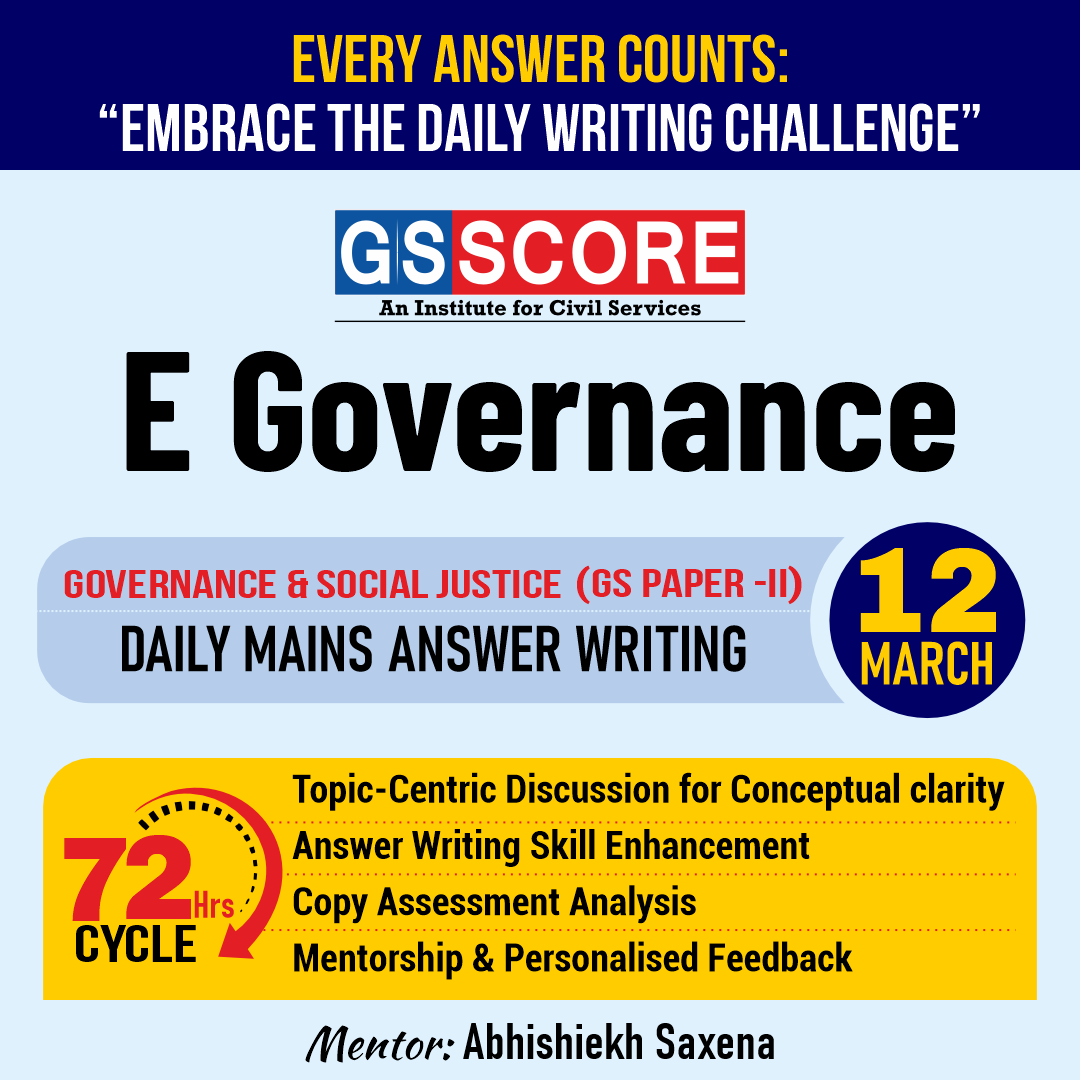


Instruction:
- There will be 2 questions carrying the First Question is-10 marks Write your answers in 150 words and the Second Question is-15 marks Write your answers in 250 words.
- Any page left blank in the answer-book must be crossed out clearly.
- Evaluated Copy will be re-uploaded on the same thread after 2 days of uploading the copy.
- Discussion of the question and one to one answer improvement session of evaluated copies will be conducted through Google Meet with concerned faculty. You will be informed via mail or SMS for the discussion.
Question #1. Not just digitization, but citizen centricity, transparency, and accountability are keys to realizing the fruits of e-Governance. Analyse. 10 marks (150 words)
Question #2. Availability, accessibility, affordability, and acceptability of E-governance initiatives are key to their effectiveness. However, most of these initiatives lack one or more of these aspects. Explain with the help of examples. 15 marks (250 words)
(Examiner will pay special attention to the candidate's grasp of his/her material, its relevance to the subject chosen, and to his/ her ability to think constructively and to present his/her ideas concisely, logically and effectively).
STEPS & INSTRUCTIONS for uploading the answers
Step 1 - The Question for the day is provided below these instructions. It will be available at 7:00 AM.
Step 2 - Uploading of Answers : Write the answer in A4 Sheet leaving proper margins for comments and feedback and upload the PDF in MY ACCOUNT section. Click on the option of SUBMIT COPY to upload the PDF.
Step 3 - Deadline for Uploading Answers: The students shall upload their answers by 7:00 PM in the evening same day. The first 50 copies will be evaluated.
Step 4 - Feedback : Mentors will give their feedback for the answers uploaded. For more personalised feedback, join our telegram channel by clicking on the link https://t.me/mains_answer_writing_cse . A one-to-one session will be conducted with the faculty after copy evaluation in 72 Hrs.
Model Answer
Question #1. Not just digitization, but citizen centricity, transparency, and accountability are keys to realizing the fruits of e-Governance. Analyse. 10 marks (150 words)
Approach:
- The question requires a detailed analysis of the necessary conditions for the realization of the full potential of e-governance including digitization.
- It is suggesting that digitization is essential for e-governance but not sufficient, as citizen-centricity, transparency, and accountability are also important.
- Give some basic insights about e-governance and its elements. Then outline the importance of digitization.
- Subsequently, mention the shortcomings of e-governance in the absence of citizen centricity, transparency, and accountability.
- Conclude, by reemphasizing the role of e-governance and suggesting some additional ways to realize its full potential.
Hint:
E-governance or ‘electronic governance’ is using information and communication technologies (ICTs) at various levels of the government for the purpose of enhancing governance. The purpose is to transform the efficiency, effectiveness, transparency, and accountability of the exchanges between the government and citizens.
Digitization is one of the pillars of e-governance and in the past few years, the government has taken various steps including Digital India with the vision to transform India into a digitally empowered society. But it is not enough as citizen centricity, transparency, and accountability are also critical for the benefits of e-governance to reach every corner of society in an inclusive manner.
Role of digitization in e-governance
- Ease of governance: Digitization helps in bringing in greater scalability in the operation of government, promotes greater coordination and communication, and simplifies bureaucratic procedures.
- Better service delivery: Cost-effectiveness, greater efficiency within the government, and leak-proof delivery of welfare services can be achieved by digitization thus making the governance service oriented. Ex. discrepancies in wage transfer in MGNREGA have been reduced with the help of digitization.
- Increasing the reach of government: Digitization helps increase the reach of government, both geographically and demographically by connectivity between the citizens and the government.
Thus digitization is an important aspect of e-governance given its immense benefits. Still, it is only a medium to serve the greater objectives of e-governance which are citizen-centricity, transparency, and accountability.
Citizen-centricity:
- Better formulation of the government programmes: Citizen-centricity can help better identify the key issues and challenges that citizens face and design e-governance solutions that are tailored to address these challenges. Thus, keeping citizens at the core of governance.
- Efficient grievance redressal: E-governance will not be effective without an adequate framework for the grievance redressal mechanism of the citizens. It makes governance responsive to the changing requirements of the citizens thus facilitating good governance.
Transparency:
- Greater access to information: Access to information is vital for the empowerment of citizens. With increased digitization, there has been some progress
- Greater trust between the state and citizens: With the focus on transparency, citizens get to know about the clear functioning of the government, allocation and utilization of resources, etc. which fosters greater trust between citizens and the state.
Accountability:
- Empowerment of stakeholders: Focus on accountability empowers the stakeholders i.e. citizens to seek justification from the government who in turn is obligated to provide a necessary explanation.
- Public confidence: Accountability provision helps in improving public confidence in government performance.
Thus the idea of e-governance goes beyond digitization. While digitization is important, it is merely means of e-governance, not the end. Citizen-centricity, transparency, and accountability are essential to ensure that the benefits of e-governance are realized efficiently. By doing so, governments can create a more responsive and accountable system of governance that better meets the needs and expectations of citizens.
Question #2. Availability, accessibility, affordability, and acceptability of E-governance initiatives are key to their effectiveness. However, most of these initiatives lack one or more of these aspects. Explain with the help of examples. 15 marks (250 words)
Approach:
- The question requires the analysis of E-governance
- The demand of the question is to examine how Availability, accessibility, affordability, and acceptability initiatives are key to the effectiveness of e-governance
- In the introduction, define governance
- Then enumerate initiatives of the government to promote E-governance but which lack any of the 4 aspects- Availability, accessibility, affordability, and acceptability
- Conclude, by suggesting a way forward
Hints:
E-Governance or `electronic governance' is basically the application of Information and Communications Technology to the processes of Government functioning.
Availability, accessibility, affordability, and acceptability of E-governance initiatives are key to their effectiveness because it leads to
- Better access to information and quality services for citizens
- Simplicity, efficiency, and accountability in the government
- Expanded reach of governance
- Resulting benefits can be less corruption, increased transparency, greater convenience, revenue growth, and cost reductions.
- Greater coordination & communication b/w departments of government
Some of the initiatives taken by the government are MyGov. DigiLocker, DARPAN etc. However, most of these initiatives lack one or more of the following aspects.
- Availability: Common Services Centres are not yet common in rural areas of the country
- Accessibility: MyGov aims to establish a link between Government and Citizens towards meeting the goal of good governance. It encourages citizens to participate in various activities i.e. discuss, poll, talk, etc. however lack of digital literacy makes this initiative inaccessible to illiterate citizens.
- Affordability: Despitecheap the internet the cost and affordability of ICT are still a big issue for rural citizens.
- Acceptability: DigiLocker serves as a platform to enable citizens to securely store and share their documents with service providers who can directly access them electronically. However, this has not yet found success yet and conventional methods continue.
Conclusion
E-Governance is getting momentum in India, but public awareness and the digital divide are important issues to be addressed. Pradhan Mantri Gramin Digital Saksharta Abhiyaan(PMGDISHA) which aims to make six crore people in rural India digitally literate is a step in the right direction.


